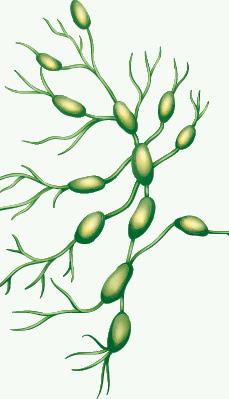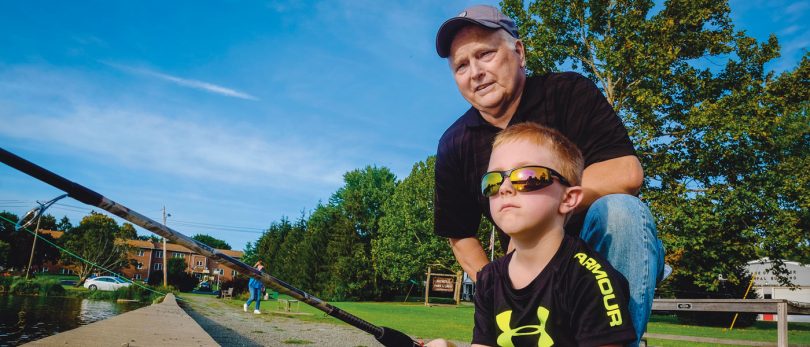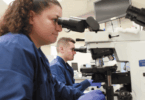Gusta “Gus” Manuel, a family man and retired foundry manager, never expected to hear the word “cancer” when he went to the emergency room in May 2015 with facial swelling but no other symptoms. “I felt fine, other than the swelling,” says Mr. Manuel. An examination revealed swollen lymph nodes in his neck, and the treating ER staff promised Mr. Manuel that they wouldn’t give up until they helped him find answers.
WHAT IS LYMPHOMA?
Lymphoma is a type of cancer that originates in the lymphatic system, the network of tissues and organs that transport white blood cells (which fight infection) and work to remove toxins and waste from the body. There are two types of lymphomas—Hodgkin and non-Hodgkin.
Follicular lymphoma is the most common form of non-Hodgkin lymphoma, and is a particularly slow-growing and often manageable cancer. It often has no symptoms until its later stages. Although Mr. Manuel had no symptoms beyond the swelling that brought him to the ER, some patients experience symptoms such as enlarged lymph nodes in the upper body (neck, underarms, abdomen or groin), fatigue, night sweats, shortness of breath and unexplained weight loss. Although these symptoms may be indicative of many things other than cancer, it’s important to bring them to the attention of your doctor.
A biopsy and other tests can confirm a diagnosis and help doctors evaluate the type and stage of the disease. In some cases, a “watch and wait” approach is best for follicular lymphomas. Depending on the stage at diagnosis and other factors, this type of lymphoma can respond well to treatments like chemotherapy and radiation.
Treatment at UHS
UHS offers treatment for lymphomas and many other types of cancer. UHS oncologists will develop a plan for your specific disease and will work with your primary care physician to manage your overall health during treatment. When treatment is over, you’ll continue follow-up care and periodic screenings with your UHS oncologist. You may be scheduled for blood tests, computed tomography (CT) or positron emission tomography (PET) scans, or further biopsies periodically after your treatment to be sure the cancer remains at bay. Remember that it’s important to get back to your life after treatment, to take care of your health and begin doing things you enjoy again.
In addition, UHS strives to improve its cancer treatment programs by being involved in and offering cutting-edge clinical trials at the local level. It’s just another step in providing high-quality care at the local level, says Dr. Harris.
Mr. Manuel was referred to Ronald Harris, DO, at UHS Medical Oncology in Johnson City, where further testing revealed a low-grade non-Hodgkin follicular lymphoma. However, Mr. Manuel’s case turned out not to be typical — his cancer had unusual features that suggested a higher grade (more serious) case. Dr. Harris notes the diligent work of UHS hematopathologists, and in particular, Jagmohan Sidhu, MD, in providing a quick diagnosis. Dr. Harris recommended a review of Mr. Manuel’s unusual case by a panel of lymphoma experts at the University of Rochester, who confirmed the diagnosis and agreed with the UHS treatment plan.
Teamwork wins
UHS provides the same standard of care as the larger cancer centers and Dr. Harris says the UHS oncology team is fortunate to have good relationships with them. “We can and do provide the same testing, diagnosis and treatments right here, so our patients don’t have to travel when they’re sick,” he says. “The support of family and friends in treatment really makes a difference.”
In Mr. Manuel’s case, staying local gave him a great deal of comfort. It meant his family could accompany him to every appointment, and his UHS Primary Care provider could continue to oversee his day-to-day treatment.
While treatment for lymphoma varies, Mr. Manuel was prescribed a course of chemotherapy in six doses over 3½ months. Mr. Manuel and his wife speak highly of the bonds they made with staff during chemotherapy appointments. “I felt fine after the first two treatments,” he says, “but I was really wiped out after the rest of them. We quarantined ourselves so I wouldn’t be around people who were sick. It was just me and my wife for quite a few weeks.”

Swollen lymph nodes: Common places to find enlarged lymph nodes are in the neck, underarms, abdomen or groin.
They took further comfort in the support and love of their four daughters, one of whom lives next door to the couple and is a nurse at the UHS Primary Care office where Mr. Manuel’s doctor works. His wife is quick to add that this daughter eased their minds about his treatment and side effects during their confinement through the later treatments.
Back in business
Two years later, Mr. Manuel has long since recovered from the chemotherapy treatments and, aside from quarterly checkups with Dr. Harris, has put the cancer behind him. An avid fisherman and devoted family man, he’s gotten back to enjoying auctions and flea markets with his wife of 47 years, and family life with his devoted daughters and 10 grandchildren. Of his experience with Dr. Harris and his cancer treatment at UHS, Mr. Manuel says, “I put all my trust in Dr. Harris and I would again. He’s a fabulous doctor.”
FROM THE ARCHIVES
Read the story of another cancer patient who benefited from UHS’ coordinated approach to oncology care.







